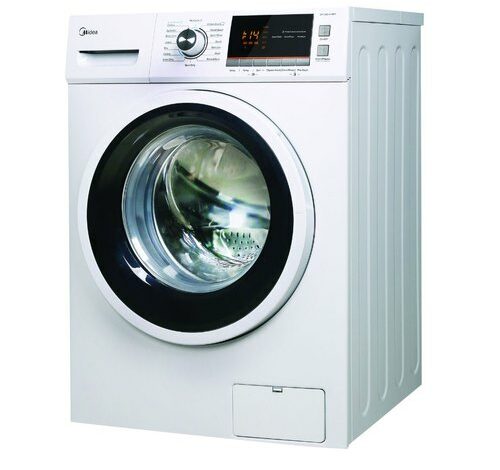Repairing the washing machine Midea in Jerusalem

If the washing machine Midea is defective, it does not necessarily have to be serviced. In some cases, the repair is not difficult, so that with a little manual skill and appropriate instructions, you can fix the damage yourself and thus save money. Here are three examples of how you can repair the washing machine yourself.
A note: Remember that the warranty is usually void if you open the washing machine and carry out repairs yourself while the warranty period is still in effect.
Replace the V-belt in Midea.
If the washing machine’s motor is running at full speed but the drum is not rotating, the V-belt is usually to blame. It is there to transfer the power of the motor to the washing drum. With older devices in particular, the V-belt – also called ribbed V-belt – can tear after many years of use or slip due to gradual wear. You can easily check whether this has happened by looking in the washing machine. To do this, open the back of the machine to check the inside.
Replacing a V-belt is not difficult. Because the spare part is available on the Internet for around 15 to 20 euros, you can easily save money if you do the repairs yourself. When ordering, pay attention to the model and year of construction of the washing machine – there are V-belts in all possible sizes and widths. Often you can also use the print on the old belt as a guide. If the belt has come off, you should definitely replace it. Experience has shown that it is only a matter of time before that happens again.
Proceed as follows to replace the V-belt:
Remember to first pull out the power plug and disconnect the washing machine from the water supply.
Remove the top cover and / or rear panel of the machine if the V-belt is not openly accessible
If the V-belt has just jumped off, it is sufficient to first re-open it to end the wash cycle. But just to be on the safe side, order a replacement strap right away to be prepared next time.
A brand new V-belt may appear too short or tight at first glance. If you use the right technique, it will still be easy to wind up by hand: To do this, first place the V-belt around the drive wheel, which is located directly on the motor shaft. Place the longitudinally ribbed V-belt around the drive wheel so that the ribs are in the grooves of the wheel and the V-belt is in the middle.
Now pull the V-belt as far as possible over the significantly larger flywheel of the washing machine drum. It can help to temporarily fix the V-belt to the flywheel using cable ties so that it does not slip. Now turn the flywheel by hand so that the V-belt opens automatically. You must then remove the cable ties with a wire cutter or knife – but be careful not to damage the V-belt.
Now all you have to do is screw the back of your washing machine Midea back on. Done!
Clean the fluff filter in Midea.
It is best to clean the washing machine’s lint filter every few months. This only takes a few minutes and can solve a wide range of problems with the washing machine or prevent them at an early stage.
The task of the lint filter is to pick up foreign bodies from the washing drum. Who has never forgotten something in their trouser pockets while washing their clothes? Over time, coins, screws and other small parts collect in the lint filter. And as the name suggests, fluff or lint also accumulates, which, together with detergent residues, can permanently stick and clog the lint filter. Waiting too long to clean the lint filter can lead to problems with the washing machine.
What happens if the lint filter is clogged? As a result, the washing water is no longer properly pumped out, the washing machine no longer spins, no longer draws water or it can no longer be opened. In addition, unpleasant smells can arise. When it stinks from the washing machine or the laundry smells unpleasant, it is high time to clean the fluff filter.
You can usually find the fluff filter at the bottom of the front of the washing machine. It is hidden behind a lid or a panel.
Remove the lid to access the lint filter. Use a suitable screwdriver or a small coin.
Have a flat container ready. Residual water can escape when the fluff filter is opened. So be prepared for a surge of water to meet you. Some washing machines also have a drain hose for this purpose. You can catch the water with a rag.
Remove the lint filter. It usually takes a turn to the left so that you can pull out the sieve.
Clean the lint filter under warm, running water. Remove coarse soiling by hand. A drain screen picks up the dirt and prevents it from clogging the drain.
Use a brush or cloth to thoroughly clean the lint filter. Also think about the rubber seal. It also needs to be cleaned so that it seals properly again afterwards.
Also clean the opening of the washing machine before putting the fluff filter back in.
You can now put the clean lint filter back in the washing machine. If you unscrewed it before, tighten it again in the opposite direction and check that it is correctly seated.
Your lint filter is now nice and clean again! Remember to clean it regularly, preferably every few weeks. The more times you thank them, the less dirt can accumulate.
You can usually find the fluff filter at the bottom of the front of the washing machine. It is hidden behind a lid or a panel.
Remove the lid to access the lint filter. Use a suitable screwdriver or a small coin.
Have a flat container ready. Residual water can escape when the fluff filter is opened. So be prepared for a surge of water to meet you. Some washing machines also have a drain hose for this purpose. You can catch the water with a rag.
Remove the lint filter. It usually takes a turn to the left so that you can pull out the sieve.
Clean the lint filter under warm, running water. Remove coarse soiling by hand. A drain screen picks up the dirt and prevents it from clogging the drain.
Use a brush or cloth to thoroughly clean the lint filter. Also think about the rubber seal. It also needs to be cleaned so that it seals properly again afterwards.
Also clean the opening of the washing machine before putting the fluff filter back in.
You can now put the clean lint filter back in the washing machine. If you unscrewed it before, tighten it again in the opposite direction and check that it is correctly seated.
Your lint filter is now nice and clean again! Remember to clean it regularly, preferably every few weeks. The more times you thank them, the less dirt can accumulate.
Replace the drain hose in washing machine Midea.
The drain hose is used to drain the used water. If there are defects in this hose or if it is clogged, it is time to replace it. This is a little more complex than the inlet hose, because you usually have to open the washing machine:
Most washing machines Midea require you to first loosen a few screws and remove the top cover or back panel.
Now you need to disconnect the drain hose from the drain pump. It is best to loosen the metal clamp with pliers and pull the hose off the pump.
Pull the waste water drainage hose out of the machine through the rear wall.
Now insert the new waste water hose. First attach it to the pump and fix it securely with the clamp. If you rub the inside of the nozzle with a little petroleum jelly, it will slide over the nozzle more easily.
Pull the drain hose through the back wall of the washing machine and then replace the washing machine cover.
Now attach the hose to the sewer pipe again as it was originally attached to you. The waste water hose is often connected to the drain of a sink via a connection on the side. To prevent it from slipping, it is securely fixed with a hose clamp. If the old one was in poor condition, it is best to replace it too, because a tight fit is extremely important – after all, you don’t want to risk water damage.
In some cases, the drain hose is simply hung with a hook-shaped end in a sink, bathtub or toilet. In these cases, make sure that the hose cannot slip off.
Tip: Have the program switch repaired.
If the program switching mechanism on older machines is broken, it usually amounts to a total write-off – at least if you commission the manufacturer’s official customer service to carry out the repairs. A new switch, including installation, often simply exceeds the current value of the washing machine. But even in such cases there is an inexpensive solution. Some experienced electronics technicians offer the repair of the program switchgear of various washing machine models over the Internet for little money.
As a rule, the defect is triggered by a so-called cold solder joint on the circuit board. The service providers measure the circuits and re-solder the affected area so that the cable is firmly in place again. In some cases defective capacitors, resistors or other electronic components are replaced. You have to remove the program switch yourself, send it in and put it back in place after the repair. Even less talented craftsmen can do this without any problems because the component is easily accessible after opening the top cover. Important: Take a photo before dismantling – this way you know exactly where you have to reinsert which cable during installation.
